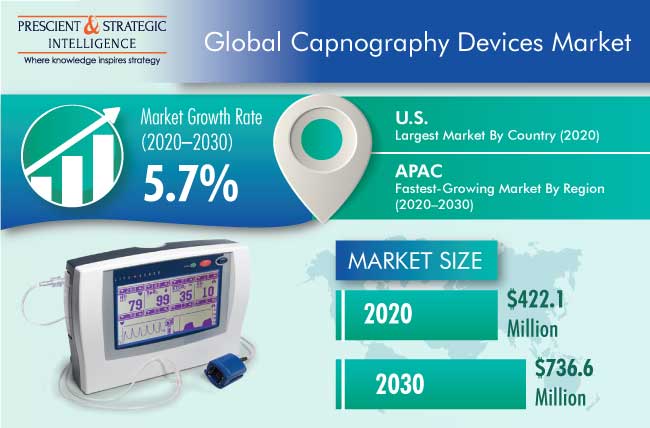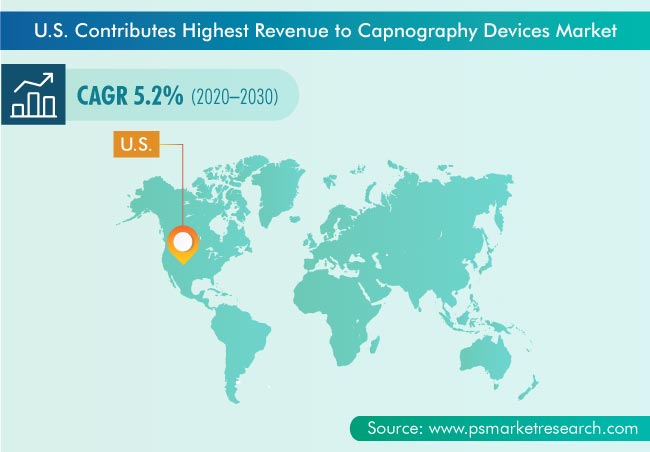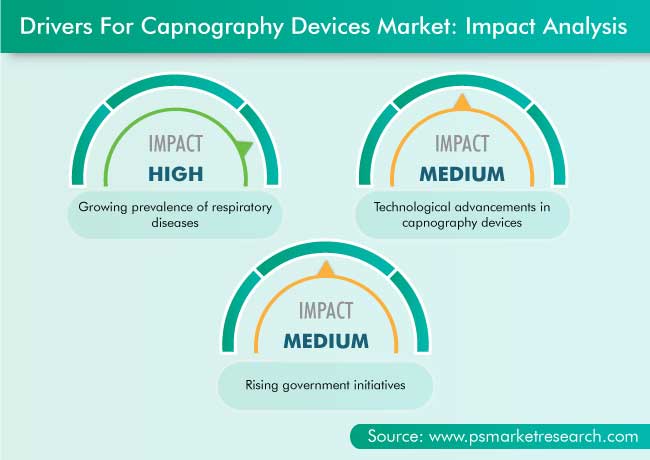Report Code: 11478 | Available Format: PDF | Pages: 318
Capnography Devices Market Research Report: By Product (Hand-Held, Stand-Alone, Multi-Parameter), Technology (Side-Stream, Main-Stream, Micro-Stream), Component (OEM Modules), Application (Emergency Medicine, Critical Care, Procedural Sedation, Pain Management), End User (Hospitals, Ambulatory Care Centers) - Global Industry Analysis and Growth Forecast to 2030
- Report Code: 11478
- Available Format: PDF
- Pages: 318
- Report Description
- Table of Contents
- Market Segmentation
- Request Free Sample
Market Overview
The global capnography devices market generated $422.1 million revenue in 2020, and it is expected to grow at a CAGR of 5.7% during 2020–2030. The key factors responsible for the growth of the market include the surging prevalence of respiratory diseases, growing geriatric population, technological advancements in capnography devices, and rising government initiatives, across the world.
In the wake of COVID-19 pandemic, the market for capnography devices and related goods has been highly impacted. With the imposition of lockdown, reduced workforce, constraints in producing goods with proper sanitization, surge in unemployment, and affected import and export services, the production facilities in countries across the globe were affected significantly. Even though, the capnography devices can be considered as the key screening tools by the healthcare professional and clinicians, who are involved in saving lives during this crucial time. Thereby, a large number patient pool is leading to the surging demand for capnography devices in healthcare and home healthcare settings.

Due to detection of multiple parameters of patients, market for multi-parameter capnography devices to witness fastest growth
The multi-parameter capnography devices category is expected to witness the fastest growth during the forecast period in the capnography devices market, on the basis of the product segment. This can be majorly attributed to the fact that these devices can be integrated into patient monitoring systems easily for the detection of multiple parameters of patients, and some of them can also be used as pulse oximeters.
Side-stream technology held largest share in 2020, as it provides quantitative bedside information about patients
Side-stream-based capnography devices held the largest revenue share in the capnography devices industry in 2020, based on technology. This is majorly due to the fact that these devices provide adequate quantitative bedside information about uneven alveolar emptying and ventilation–perfusion mismatch, and this technology requires no calibration before use and has an extremely short warm-up time facilitating its use in emergency situations.
Due to ability of making EtCO2 or CO2 monitoring simple, OEM modules category to witness faster growth
The original equipment manufacturer (OEM) modules category is expected to record faster growth during the forecast period in the capnography devices market, based on component. This can be mainly due to their ability of making end-tidal carbon dioxide (EtCO2) or carbon dioxide (CO2) monitoring simple and accurate, even in smaller and portable monitors.
Due to increased safety of patients, emergency medicine category dominated the market
The emergency medicine category held the largest share in the market for capnography devices in 2020, as these devices are most commonly used in emergency medicine. Moreover, use of capnography devices has been considered to increase the safety of sedating patients in the emergency department, leading to the increasing use of these devices.
Hospitals category to witness fastest growth, owing to rising demand for capnography in these facilities
The hospitals category is projected to witness the fastest growth in the capnography devices market during the forecast period, based on end user. This can be mainly attributed to the increasing demand for capnography devices in emergency and critical care departments of hospitals.
North America led the market, due to high prevalence of respiratory diseases
Globally, North America was the largest market for capnography devices in 2020. This is mainly driven by the high prevalence of respiratory medical conditions, presence of prominent market players offering capnography devices, improved healthcare infrastructure, and high awareness amongst healthcare professionals, in the region.

Increasing number of acquisitions and partnerships is a key market trend
Acquisitions and partnerships among players operating in the capnography devices market are resulting in the improved patient accessibility to new technologies, providing enhanced patient outcome. For instance, in May 2020, Masimo Corporation and Koninklijke Philips N.V. announced their partnership, whereby Philips would integrate additional Masimo Corporation’s measurement technologies into select IntelliVue MX-series multi-parameter monitors, to help clinicians assess cerebral oximetry and ventilation status. With such acquisitions and partnerships, it is expected that the manufacturing of capnography devices would increase in the coming years.

Growing prevalence of respiratory diseases is driving the demand for capnography devices
The rising prevalence of respiratory diseases, such as chronic obstructive pulmonary disease (COPD), pulmonary embolism, and asthma, which require intensive respiratory monitoring, is expected to drive the market for capnography devices in the coming years. According to the study, “The Global Burden of Diseases” by the World Health Organization (WHO), the number of cases of COPD is predicted to rise over the forecast period. Moreover, COPD is one of the major causes of deaths, and its incidence is increasing at a high rate. The study also reported that there were around 3.17 million deaths due to COPD in 2015, which increased to 3.23 million in 2019. The devices are increasingly being adopted by physicians and patients for the management of respiratory disorders, as these devices facilitate medical intervention in acute as well as chronic patients.
Technological advancements in capnography devices is propelling the market growth
Technological advancements in capnography have been the major driving factor of the capnography devices market, which include the incorporation of photo detectors and MCS in micro-stream capnography devices, and the incorporation of miniaturized main-stream multi-gas monitors. Because of these advancements, the capnography devices demonstrate high accuracy and safety levels, and also have adjustable flow rate, which prevents moisture contamination and facilitates retrieval of large sample volume. For instance, in September 2020, Capsule Technologies, a trademark of Capsule Technologie SAS, received the Food and Drug Administration (FDA) 510(k) clearance for its new connected capnography-monitoring technology, which is a Vitals Plus monitoring solution. Moreover, it was created to incorporate Masimo's NomoLine ISA CO2, and designed to keep track of a patient's EtCO2, respiratory rate, and FiCO2.
| Report Attribute | Details |
Historical Years |
2015-2020 |
Forecast Years |
2021-2030 |
Base Year (2020) Market Size |
$422.1 Million |
Market Size Forecast in 2030 |
$736.6 Million |
Forecast Period CAGR |
5.7% |
Report Coverage |
Market Trends, Drivers, and Restraints; Revenue Estimation and Forecast; Segmentation Analysis; Country Breakdown; Impact of COVID-19; Companies’ Strategic Developments; Company Profiling |
Market Size by Segments |
By Product; By Technology; By Component; By Application; By End User; By Region |
Market Size of Geographies |
U.S; Canada; Germany; France; U.K.; Italy; Spain; Japan; China; India; Australia; Brazil; Mexico; Saudi Arabia; South Africa; U.A.E. |
Secondary Sources and References (Partial List) |
Centers for Disease Control and Prevention; American Association of Physicists in Medicine; American Brachytherapy Society; American Registry of Radiologic Technologists; American Society of Radiologic Technologists; Australian Institute of Health and Welfare; European Society for Radiotherapy and Oncology; International Medical Device Regulators Forum; United States Food and Drug Administration; U.S. National Library of Medicine; World Health Organization |
Explore more about this report - Request free sample
Industry players involve in product launches to gain significant market position
The global capnography devices market is fragmented in nature. Some of the major players in the industry include Diamedica (UK) Limited, Shenzhen Comen Medical Instruments Co. Ltd., Edan Instruments Inc., Nonin Medical Inc., Drägerwerk AG & Co. KGaA, Nihon Kohden Corporation, Masimo Corporation, Becton, Dickinson and Company, Medtronic plc, Smiths Group plc, Koninklijke Philips N.V., Welch Allyn Inc., Zoll Medical Corporation, and Shenzhen Mindray Bio-Medical Electronics Co. Ltd.
In recent years, these players have been involved in product launches and their approvals, in order to attain a significant market position. For instance:
- In March 2020, Masimo Corporation announced that continuous RRp monitoring of adult and pediatric patients with Rad-97, Radical-7, and Radius-7 Pulse CO-Oximeters had received the FDA clearance. With this clearance, both continuous and spot-check RRp are now available in the U.S., supported in a variety of pulse oximetry sensors and configurations, including the new non-cabled, tetherless, and wearable Radius PPG.
Key players in capnography devices market include:
-
Diamedica (UK) Limited
-
Shenzhen Comen Medical Instruments Co. Ltd.
-
Edan Instruments Inc.
-
Nonin Medical Inc.
-
Drägerwerk AG & Co. KGaA
-
Nihon Kohden Corporation
-
Masimo Corporation
-
Becton, Dickinson and Company
-
Medtronic plc
-
Smiths Group plc
-
Koninklijke Philips N.V.
-
Welch Allyn Inc.
-
Zoll Medical Corporation
-
Shenzhen Mindray Bio-Medical Electronics Co. Ltd.
Market Size Breakdown by Segments
The capnography devices market report offers comprehensive market segmentation analysis along with market estimation for the period 2015-2030.
Based on Product
- Hand-Held
- Stand-Alone
- Multi-Parameter
Based on Technology
- Side-Stream
- Main-Stream
- Micro-Stream
Based on Component
- Original Equipment Manufacturer (OEM) Modules
- Infrared sensors
Based on Application
- Emergency Medicine
- Critical Care
- Procedural Sedation
- Pain Management
Based on End User
- Hospitals
- Ambulatory Care Centers (ACCs)
Geographical Analysis
- North America
- U.S.
- Canada
- Europe
- Germany
- U.K.
- France
- Italy
- Spain
- Asia-Pacific (APAC)
- China
- Japan
- India
- Australia
- Latin America (LATAM)
- Brazil
- Mexico
- Middle East and Africa (MEA)
- South Africa
- Saudi Arabia
- U.A.E.
In 2030, the value of the capnography devices market will be $736.6 million.
Hand-held is the largest category under the product segment of the capnography devices industry.
The major capnography devices market drivers are growing prevalence of respiratory diseases, technological advancements in capnography devices, and rising government initiatives.
North America is the largest and APAC is the fastest-growing capnography devices market.
Most capnography devices market players are adopting the strategy of product launches and their approvals to sustain their business growth.
Want a report tailored exactly to your business strategy?
Request CustomizationWant an insight-rich discussion with the report author?
Speak to AnalystOur dedication to providing the most-accurate market information has earned us verification by Dun & Bradstreet (D&B). We strive for quality checking of the highest level to enable data-driven decision making for you
Our insights into the minutest levels of the markets, including the latest trends and competitive landscape, give you all the answers you need to take your business to new heights
With 24/7 research support, we ensure that the wheels of your business never stop turning. Don’t let time stand in your way. Get all your queries answered with a simple phone call or email, as and when required
We take a cautious approach to protecting your personal and confidential information. Trust is the strongest bond that connects us and our clients, and trust we build by complying with all international and domestic data protection and privacy laws